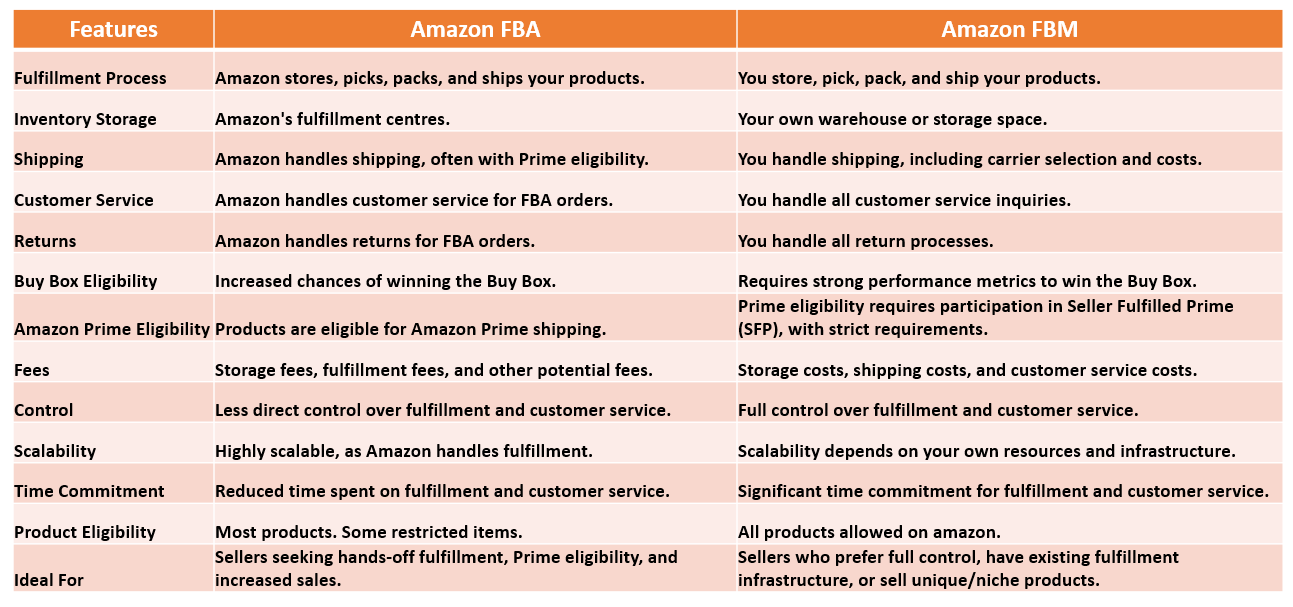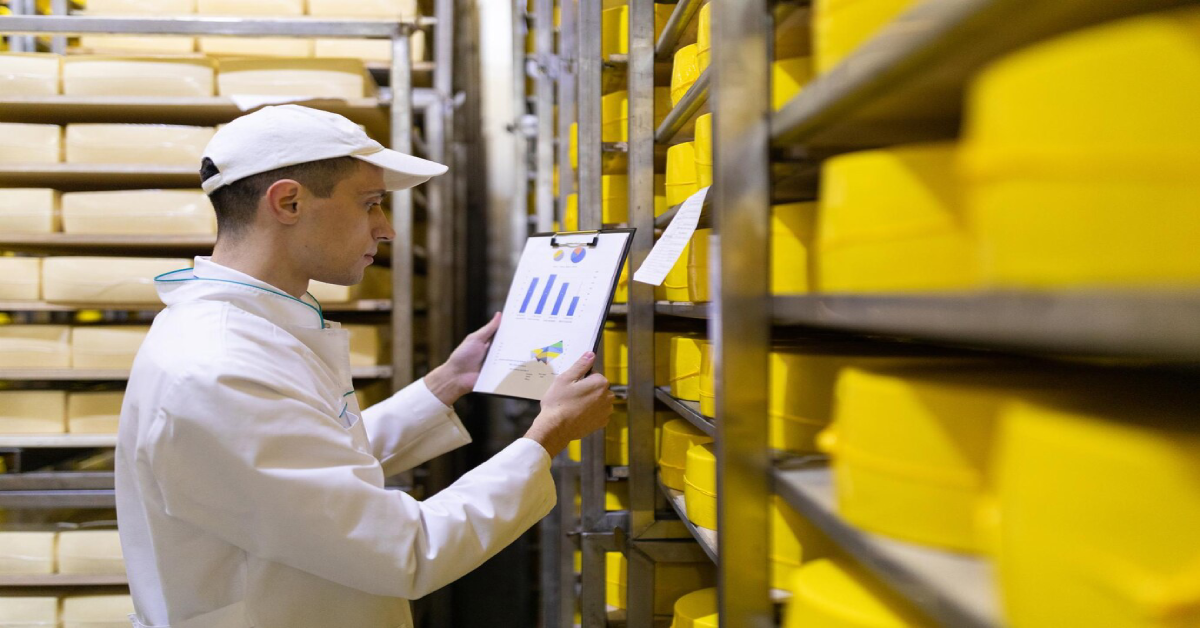Amazon FBA vs. FBM: Selecting the Appropriate Fulfillment Path for Your Business
One of the most important choices an Amazon seller faces is which fulfillment method they will use to fulfill and ship orders. Will you do it yourself, aka Fulfillment by Merchant (FBM), aka the Merchant Fulfilled Network, or will you use Amazon’s fulfillment network, aka Fulfillment by Amazon (FBA)?
This is a common predicament, and you are not the first person or company to weigh the pros and cons of either. There are pros and cons of both FBA and FBM, making this important to your success on Amazon.
This guide presents the information regarding Amazon FBM vs Amazon FBA, so you can make an informed decision based on what is best for your business strategy, goals, and available resources, and to increase sales and growth potential on Amazon.
FBA vs. FBM: A Quick Comparison to Help You Begin the Decision-Making Process
Now that you have a broader understanding of Amazon fulfillment, you’re probably ready for a tangible comparison chart of FBA vs. FBM fulfillment options. This chart serves as a snapshot comparison to give you an initial understanding of which format might fit your needs better. But we will expand upon the previous comparison, giving you a deeper understanding so you can decide with confidence and make general improvements to your Amazon selling strategy moving forward.

Amazon FBA: Supercharge Your Sales or Face the Fees? A Comprehensive Look
Should You Use Amazon FBA to Boost Your Sales or Does It Just Cost Too Much? Here are the pros and cons of using Amazon FBA.
Using Amazon FBA could have a major impact on your sales and operations. Choosing to use Amazon FBA can dramatically affect sales and operations. Here’s an overview of its important benefits and drawbacks to help you decide if it’s right for your business.
Benefits of Using Amazon FBA
-
Ship Through Amazon Prime: Access to Millions of Customers
- Leverage Amazon’s vast base of (millions of) Prime members, who have higher-order frequency and order value
- They gain benefits from the free two-day shipping of Amazon Prime that shoppers love.
- Increase your sales and earnings with the goodwill of the customers with Amazon Prime.
-
Winning the “Buy Box”: Increased Sales Opportunity
- FBA gives you a much higher chance of winning the coveted “Buy Box,” that is, the “Add to Cart” button.
- Winning the Buy Box is important to increase sales.
-
Use Amazon’s Fulfillment Expertise for Worry-Free Logistics
- Use Amazon’s advanced fulfillment and logistics network to process and ship your orders.
- You will have more time for other important things.
-
Improved Customer Experience: Effortless Customer Service and Returns
- Customer service inquiries and return processing for FBA orders are handled by Amazon will enhance customer satisfaction.
-
Improved Search Ranking: More Visibility
- FBA products have better placements on Amazon searches, creating more visibility and sales opportunities.
Cons of Amazon FBA
-
Higher Fees
- FBA comes with different fees, including fulfillment fees and storage fees. All these have an impact on your profit margin.
- For small, light items, FBA is the most cost-effective.
- Don’t forget about the usual Amazon selling fees as well.
-
Pay To Store Your Inventory, Ongoing Costs
- You can pay Amazon to store your inventory in the fulfillment center. Storage fees will differ depending on how long it is stored and its size.
-
Commingling Risks: Potential Product Mix-Ups
- Your products may be commingled with those of other sellers, potentially leading to quality control issues if other sellers’ products are of a lower quality.
-
Strict Packaging Requirements: Limited Flexibility
- Adhere to Amazon’s stringent packaging requirements, which can be time-consuming and limit your flexibility.
-
Tax Obligations: State-Specific Liabilities
- FBA can create tax obligations in states where Amazon has fulfillment centers, requiring careful compliance.
- FBA Pros and Cons at a Glance:
E-commerce Fulfillment: In-House vs. Outsourced – Which Path Is Right for You?
As an e-commerce seller, mastering fulfillment—the art of storing, packing, and shipping products—is crucial for success. You have two primary options: handling it yourself (FBM) or outsourcing (FBA). Which approach best suits your business? Let’s explore key considerations:
1. Time and Effort: Reclaim Your Focus
- FBM (Fulfillment by Merchant): Ideal if you have the time and resources to manage fulfillment in-house.
- FBA (Fulfillment by Amazon): This is Perfect if you’re time-constrained or want to delegate:
- Inventory receiving and storage.
- Order picking and packing.
- Shipping and tracking.
- Customer service and returns
2. Cost Analysis: Maximize Your Margins
-
FBM Costs
- Storage space (purchase or lease).
- Packaging and labeling.
- Shipping and delivery.
- Inventory management.
- Customer service.
-
FBA Cost
- Selling plan fees (Individual or Professional)
- Referral fees.
- Fulfillment fees (weight, product category).
- Inventory storage fees (space, duration).
- Returns processing.
-
Cost Savings
FBA shipping can be significantly cheaper than standard carrier options. Use the Amazon Revenue Calculator to estimate costs and potential savings.
-
FBA cost-saving analysis
FBA costs 70% less per unit on average than premium options offered by major US carriers comparable to FBA, and it costs 30% less per unit on average than their standard shipping options.
-
Control and Customization
Tailor Your Brand Experience
- FBM: Full control over packaging, shipping carriers, and product selection.
- FBA: Adherence to Amazon’s policies and restrictions.
- Trade-offs: Weigh the importance of control against the benefits of FBA’s expertise and efficiency.
4. Sales Volume and Scalability
Adapt to Your Growth
- FBM: Suitable for startups and low-volume sellers.
- FBA: Ideal for high-volume businesses seeking scalability and access to Amazon’s global network.
5. Customers want to have fast, free shipping
After placing an order, the customer wants the delivery to be as quick as possible!
- Customers want it free and want it fast. Giving the customer what they want can change your sales too! It is said that “no one likes to wait” and that is true even in shopping. It is a dire need all around and businesses must keep it in mind or risk losing customers.
- Start forecasting your revenue with easy monthly targets. Your demand for delivery for customers is crucial.
Excessive Delivery Times Can Result in The Abandonment Of Carts. How To Make The Right Choice?
- Examine your time, budget, and operational requirements:
- Think about how much you sell, what your product is like, and what your customers expect.
- Make informed choices using Amazon’s tools like the Revenue Calculator. Go with a Hybrid plan. If you balance and compare these factors, then you can choose the fulfillment strategy.
Fulfillment by Merchant (FBM): Can You Compete with Amazon FBA?
For Amazon sellers seeking greater control and potentially higher margins, Fulfillment by Merchant (FBM), also known as the Merchant Fulfilled Network (MFN), offers a compelling alternative to Amazon’s FBA program. With FBM, you take full responsibility for storing, packing, shipping, and handling customer service and returns.
Is FBM Right For You?
Key Requirements:
Before diving into FBM, ensure you have the following in place:
- Dedicated Inventory Storage: A well-organized space to store your products.
- Reliable Logistics Network: A dependable shipping solution to ensure timely deliveries.
- Efficient Order Processing: The ability to quickly and accurately package and label orders.
- Robust Customer Support: The capacity to handle returns, refunds, and customer inquiries effectively.
Amazon Seller Fulfilled Prime (SFP):
- Prime Benefits Without FBA: For sellers who want the best of both worlds, Amazon Seller Fulfilled Prime (SFP) allows you to display the Prime badge on your self-fulfilled listings. This unlocks Prime benefits without the FBA fees but requires meeting stringent performance standards.
- SFP Requirements: 99% on-time shipping rate. <0.5% cancellation rate. 98.5% usage of Amazon Buy Shipping services. Amazon handled customer service inquiries. Usage of Amazon-supported SFP carriers. A 30-day trial period to prove you can meet these requirements.
Benefits of Using FBM:
- More Control Over Packaging: Customize your packaging for your brand and customer experience.
- Simplified Inventory Tracking: You’ll keep total control of your inventory inside your own storage unit.
- Better profits: Steer clear of FBA charges and extra storage fees to boost your profits.
- Competition in Buy Box (with SFP): Get SFP to compete for the Buy Box and enjoy Prime visibility. You can fulfill orders from various channels from your warehouse.
Disadvantages of Using FBM:
- Stiff Competition from FBA Sellers: Prime-eligible FBA listings have the added benefit of the customer’s first choice.
- More Costs: Include warehousing, staffing, and shipping costs into account.
FBM Pros and Cons at a Glance:
Is FBM Your Ideal Fulfillment Strategy? 5 Key Factors to Evaluate
Fulfillment by Merchant (FBM) offers e-commerce sellers control and flexibility. But is it the right fit for your business?
Before committing to FBM, carefully consider these five crucial factors:
1. Product Characteristics and Handling
• Size and Weight: Are your products easily stored and shipped from your location? Oversized or heavy items might make FBM more complex and costly.
• Fragility and Special Needs: Do your products require specialized packaging or handling? Fragile or perishable items demand careful management.
• Storage Requirements: Do you have the space and conditions (climate control, etc.) necessary for proper inventory storage?
2. Fulfillment Infrastructure and Resources:
- Storage Space: Do you have ample, organized storage space for your inventory?
- Packaging and Shipping: Can you efficiently pack and ship orders, including labeling and tracking? • Logistics Network: Do you have reliable shipping partners and systems in place for timely delivery?
- Staffing: Do you have the personnel to handle order processing, packaging, and shipping?
3. Customer Service and Returns Management:
- Customer Interaction: Do you enjoy direct customer communication and problem-solving?
- Return Processing: Can you efficiently manage returns, refunds, and exchanges?
- Customer Support: Do you have the capacity to handle customer inquiries promptly and professionally?
4. Sales Volume and Order Frequency:
- Low to Moderate Volume: FBM is often well-suited for businesses with lower sales volumes and less frequent orders.
- Seasonal or Sporadic Sales: If your sales fluctuate, FBM allows for greater flexibility in managing inventory and fulfillment.
- Scalability: Consider if your current infrastructure can handle future growth in sales volume.
5. Profit Margins and Cost Management:
- Cost Analysis: Carefully calculate all FBM-related costs (storage, packaging, shipping, labor) and compare them to potential FBA fees.
- Control Over Costs: FBM offers greater control over costs, but requires careful management to ensure profitability.
- Margin Optimization: If you prioritize maximizing profit margins and have efficient cost management, FBM can be a viable option.
When would FBA be right for you?
- Your Business sells unique products or specialized goods.
- You want to control your brand and engage customers.
- There is already a fulfillment infrastructure and resources available at your disposal.
- You have a low to moderate sales amount.
By assessing these five factors, you can identify whether FBM is in line with your business objectives and operational capabilities.
Choosing whether to use Amazon FBA services or FBM
Selecting FBA or FBM services depends on your individual business situation. To help you understand better, refer to the following points.
Choose Amazon FBA When:
- You have high-demand, fast-turning products: Amazon’s fulfillment network excels at handling large order volumes.
- You want Prime eligibility and Buy Box advantages: FBA significantly boosts your chances of securing these valuable benefits.
- You sell small, lightweight items: This will reduce FBA fees and boost profit margins.
- You want to outsource fulfillment and customer service: Free up your time to focus on other aspects of your business.
Use Amazon FBM or Seller Fulfilled Prime (SFP) When:
- You have low-volume, slow-moving products: Slow-moving items can wreak havoc on your overall bottom line if they are subjected to costly FBA storage fees.
- You have shipping capabilities: Utilize the logistics you already have in place.
- You offer big, heavy, or unique products: This allows for greater control over packaging and limits potential damage during fulfillment.
Avoid FBA fees and seize an opportunity where it would be possible to increase your profitability. You should fulfill the stringent criteria of SFP if you wish to gain the prime benefits without the FBA fees.
Key Considerations:
- Business Scale: Assess your current and projected sales volume.
- Product Type: Consider size, weight, and specialized packaging needs.
- Profit Margins: Carefully calculate potential fees and costs.
- Resources and Capabilities: Evaluate your ability to manage fulfillment and customer service.
When you deliberate on these factors, you’ll be able to choose the best fulfillment option that will align with your business goal and will maximize your success on Amazon.
Five factors to Consider when Choosing Between FBA vs FBM for your Business
I. Product Type and Characteristics
1. Size and Packaging:
- Small, easily packaged items may suit FBM.
- Large or complex items often benefit from FBA’s professional handling.
2. Special Requirements:
- Perishables, hazardous materials, and fragile items have specific storage and shipping needs.
- FBA has product restrictions, so always check eligibility.
3. Fulfillment Costs:
- Storage, shipping, and handling costs vary significantly based on product dimensions and weight for both FBA and FBM.
II. Personalization and Time Investment
1. FBM for Personal Touch:
- If you enjoy direct customer interaction or want to customize packaging, FBM offers greater control.
2. FBA for Time Savings:
- If you prefer to focus on business growth, FBA handles fulfillment, freeing up your time.
III. Inventory Management Preferences
1. Storage Capabilities:
- Do you have sufficient storage space?
- Consider storage duration, turnover rate, and special requirements (climate control).
2. Inventory Access:
- FBM provides constant access to your inventory.
- FBA manages inventory, saving you time and resources.
IV. Customer Service and Returns Handling
1. FBM for Direct Interaction:
- Enjoy personal customer communication and handle returns directly.
2. FBA for Outsourced Support:
- Amazon manages customer service and returns, simplifying your operations.
3. Customer Feedback:
- Utilize Seller Central’s Customer Review Insights to monitor customer sentiment.
- Enroll in Amazon Brand Registry for the Customer Reviews tool to consolidate and analyze reviews.
V. Sales Volume and Speed
1. Sales Pattern:
- So, If you are doing steady sales throughout the year, you can benefit from the scalability of the FBA.
- If your sales are seasonal or occasional, then FBM would suit better due to their flexibility
2. Demand Management:
- Your fulfillment needs will be impacted by sales volume (amount) and sales velocity (speed).
- Seasonal small businesses may do well with FBM
- High-volume businesses often benefit from FBA’s efficiency.
3. Keeping up with demand:
- FBA can help with large volume, while FBM can be better for smaller operations.
In order to determine the best fulfillment method for your Amazon business and maximize efficiency and profitability, assess these five factors carefully.
Maximize Your Reach: Combining FBA and FBM for Amazon Success
Of course, you do not have to limit yourself to just one fulfillment method on Amazon. Using both Fulfillment by Amazon (FBA) and Fulfillment by Merchant (FBM) in a thoughtful way will help you complete your operations and serve your product needs better.
I. Leveraging a Hybrid Fulfillment Strategy
- Flexibility and Optimization: Tailor your fulfillment approach based on individual product characteristics, sales velocity, and storage requirements.
- Diversification: Mitigate risks by not relying solely on one fulfillment method. Beyond FBA and FBM, consider these complementary services:
- Multi-Channel Fulfillment (MCF): Extend Amazon’s FBA expertise to fulfill orders from your own website and other sales platforms.
- Consolidate your fulfillment operations for increased efficiency.
II. Seller Fulfilled Prime (SFP)
- Display the coveted Prime badge on your self-fulfilled listings.
- Demonstrate your ability to meet Prime shipping standards and gain customer trust. o Allows you to retain control, but still gain prime benefits.
- Buy with Prime:
- Show the prime logo and delivery promise on your own website. This has been shown to increase conversions.
III. Strategic Implementation
- Utilize FBA for high-demand, fast-moving products and those that benefit from Prime eligibility.
- Employ FBM for specialized, oversized, or slow-moving items.
- Explore MCF to streamline fulfillment across multiple sales channels.
- Consider SFP for products you wish to retain control over but still wish to have prime branding.
- Consider Buy with Prime to increase conversions on your own website.
By strategically combining these fulfillment options, you can optimize your Amazon business, enhance customer satisfaction, and drive significant growth.
Learn more about how Versa Cloud ERP and Amazon FBA and FMA integration
Take the First Step Towards Transformation
By taking a collaborative approach, Businesses can build a culture of continuous improvement and achieve sustainable operational efficiency without overwhelming your team or disrupting your business.
Don’t let inventory challenges hold your business back. Discover the Versa Cloud ERP advantage today.
Effectively manage your accounting, financials, multiple channel inventory, and production workflows with our award-winning ERP.
Let Versa Cloud ERP do the heavy lifting for you.
Do Business on the Move!
Make your businesses hassle-free and cut the heavyweights; sign up for the Versa Cloud ERP today!!
Join our Versa Community and be Future-ready with us.











